RFID asset management
1.1 System Overview
RFID is the abbreviation for Radio Frequency Identification, or Radio Frequency Identification. Is a non-contact automatic identification technology, it is through the radio frequency signal automatically identify the target object and obtain relevant data, identification work without manual intervention, can work in a variety of harsh environments. RFID technology can identify high-speed moving objects and can identify multiple tags at the same time, which is quick and convenient to operate. It can be used repeatedly tens of thousands of times, readable and writable. Working hours up to 8 years
RFID technology is bringing a huge change to the logistics field, it is to identify the speed, distance, electronic tags are not easy to damage, large capacity and other advantages to replace the position of bar codes in logistics, thereby simplifying the complicated work process, effectively improve the efficiency and transparency of logistics in and out of the warehouse. You can understand the production progress and completion of each order anytime, anywhere.
1.2 System composition
The most basic RFID application system consists of three parts:
As shown in the figure:
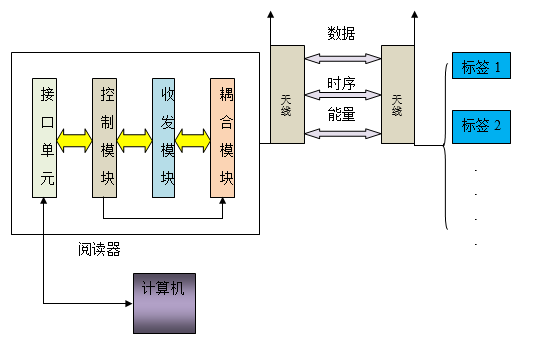
A 标签(Tag) B 阅读器(Reader) C 天线(Antenna)
Tag: Consists of a coupled element and chip, each tag has a unique electronic code, attached to the object to identify the target object; Electronic tags are able to store data about objects. In the automatic identification management system, each electronic tag holds information such as the attributes, status, and number of an object. Electronic tags are usually mounted on the surface of an object and have a certain angle of view without metal occlusion.
Reader: A device that reads (and sometimes writes) tag information, which can be designed as handheld or fixed, and its main functions are: – to view the data information currently stored in the electronic tag; — Write the data information to be stored to the blank electronic tag; — Modify (rewrite) the data information in the electronic tag.
Antenna: Transmits an RF signal between the tag and the reader.
1.3 Warehouse functional planning
The application of RFID is mainly to the warehouse and production and circulation assets for management, warehouses have a variety of forms, some warehouses are standardized, the entry and exit of goods are with logistics trays, some warehouse storage is relatively simple, some warehouses are large warehouses, more goods, the need to locate assets with management. Therefore, when designing RFID, it is necessary to consider many types of warehouses, and different warehouse functions and application characteristics need to be considered in the selection of RFID tags and readers.
1.4 Tag selection specification
The operating frequency of the RF tag is also the operating frequency of the RF identification system. The operating frequency of the RF tag not only determines the working principle of the RF identification system (inductive coupling or electromagnetic coupling), the recognition distance, but also determines the difficulty of the IMPLEMENTATION of the RF tag and the reader and the cost of the device. It is recommended to produce circulation standard cards that can be used repeatedly.
Ultra-high frequency (UHF) segment RF tags
UHF RF tag, referred to as microwave RF tag, its typical operating frequency is: 860M ~ 960MHz, typical case of 4-6m, the maximum up to 10m or more. Reader antennas are generally directional antennas, and only RF tags within the directional beam range of the reader antenna can be read/written.
Different types of warehouses, in the storage of goods are different, based on economic and practical considerations, the warehouse needs to use different labels according to different types of goods, types, etc., the following table lists the types of labels used in different warehouses, through the classification management of labels to strengthen a standardized management of the warehouse.
The application of this label mainly adopts the following categories
UHF mainly applies a small number of valuables, and the recommended use of high-frequency labels for large-volume million-level small items is to reduce costs. The bar code system recommends that the original established bar code system be included in the management, and gradually replaced by high-frequency or ultra-high frequency labels in the later stage.
1.5 Reader-writer selection specification
| Warehouse classification | Handheld (support UHF, 2D code, 1D barcode) | All-in-one reader | remark |
| A type of warehouse More than 1000 square meters | √ | √ | Integrated installation at the entrance to and from the warehouse |
| Class II repositories 100-1000 sqm | √ | √ | Integrated installation at the entrance to and from the warehouse |
| Three types of warehouses Less than 100 square meters | √ | √ | Integrated installation at the entrance to and from the warehouse |
1.6 RFID warehouse management function
Multi-warehouse, multi-cargo owner support: based on multi-organization management, to achieve independent operation of outlets in various places, centralized management in operation; Workflow-driven, work collaboration between various business entities is connected. Provide highly flexible business process configuration, support different job processes and strategies for different shippers.
Intelligent operation strategy support: Provide intelligent listing, picking, and replenishment strategy configuration functions to meet the needs of external and changeable operations. Use optimization algorithms to generate reasonable work plans; Optimize the inventory placement layout and maximize the use of storage capacity; Optimize the warehouse operation line, save the workload of forklift trucks and operators, and solve the operation bottleneck.
Customer service management: extend informatization to both ends of the value chain, strengthen information interaction and collaboration with customers, build an integrated customer service system in the three stages of pre-sale, sale and after-sales, create a solid customer base for enterprises, and use informatization to shape a customer-oriented operating model.
Accurate automatic billing: the system provides a variety of cost project settings and a variety of cost settlement methods, according to the actual operation, the system automatic settlement; Support the cost calculation of various preferential strategies such as complex multi-contract, cost transfer, and stack-free period in third-party warehousing; Support interface with financial systems;
Support logistics equipment integration: the system supports the combination of HARDWARE equipment such as RF, electronic tags, RFID, and electronic gates to improve the accuracy and timeliness of operations in the library and reduce human errors; Promote the assessment and management of enterprise operation performance.
Warehouse management detailed flow chart

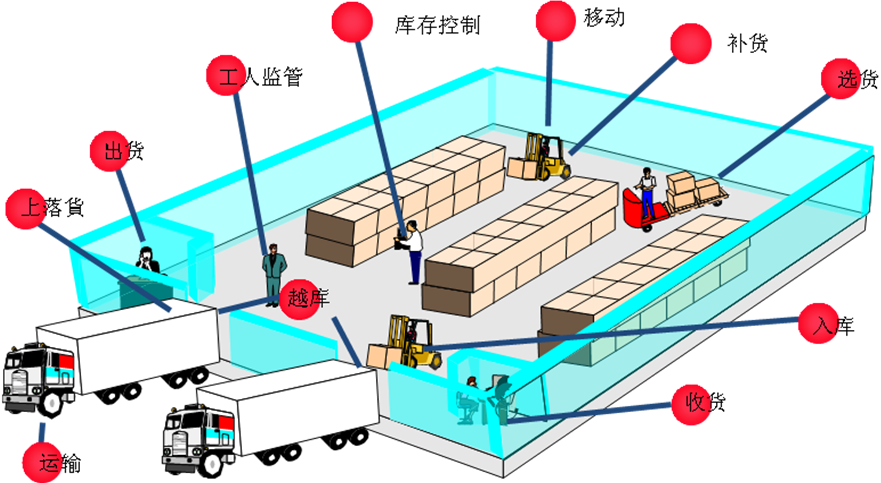
Storage:
Before warehousing, the card issuer is used to write the goods information of the entire pallet, and the written information includes a series of attributes such as name, category, quantity, date, etc., and the electronic tag is installed on the pallet after writing; When warehousing, the handheld reader is used to read the electronic tag on the tray, and after the reader reads, the information is transmitted to the background management system to automatically generate the storage order, realizing full automatic storage.
The specific process is: when warehousing, collect the electronic tags on the large package and transfer the data on the same tray to the data center; Scan the electronic label on the tray to establish a one-to-many association of the electronic label with several labels. When warehousing, register at the warehousing acceptance office, the data center after analysis and judgment, analyze the placement of this item and display the location number on the large display screen in front of the entrance, scan the electronic tag, write the bin location information to the electronic tag, realize the correspondence between the space bin location and the electronic tag, and the staff will store the items according to the location information.
Inventory:
The handheld reader is used for warehouse inventory, and the reading distance is 1-2 meters, so as long as the staff uses the handheld reader to be within 2 meters of the pallet label, the handheld reader will automatically read and collect the information of the pallet and save it in the PDA, or pass The PDA data line is connected to the system and transmitted to the background management system to achieve accurate and efficient inventory counting.
Outbound:
Through the background management system to query the placement of the items to be out of the warehouse, take out the items, the items in the warehouse, the use of handheld readers to read the information of the electronic label on the tray, the reader will be associated with the pallet label of the bar code information sent to the warehouse management system for outbound record backup and data update, saving the labor cost of scanning the bar code package by package.
The specific process is: when leaving the warehouse, the staff takes the invoice to the data center and finds the storage location of the goods to be shipped out of the warehouse through the data center. Scan the electronic label on the tray, and the whole package of barcode information associated with the electronic label is passed into the system to form a warehouse list; After the data processing center receives the data, it updates the data.
Transportation links
In transportation management, goods and vehicles transported in transit are labeled with RFID tags, and RFID receiving and forwarding devices are installed at some checkpoints of the transport line. After the receiving device receives the RFID tag information, it is uploaded to the transportation dispatch center together with the location information of the receiving place.
Distribution/Distribution Links
In the distribution process, the use of RF technology can greatly accelerate the speed of distribution and improve the efficiency and accuracy of the picking and distribution process, and can reduce labor and reduce distribution costs.
If all goods arriving at the central distribution center are labeled with RFID tags, when entering the central distribution center, the pallet passes through a reader that reads the label contents on all the boxes on the pallet. The system checks this information with the shipment record to detect possible errors and then updates the RFID tag to the latest item storage location and status. This ensures precise inventory control and even an accurate understanding of how many containers are currently in transit, where and where they are coming from and where they are being transferred, and the expected arrival time.
Production links
The application of RFID technology in the production and manufacturing process can complete the operation of the automated production line, realize the identification and tracking of raw materials, parts, semi-finished products and finished products on the entire production line, reduce the cost and error rate of manual identification, and improve efficiency and efficiency. RFID technology can also help managers to send replenishment information in a timely manner according to the production progress, achieve balanced and steady production of assembly lines, and also strengthen the control and tracking of quality.
1.7 Warehousing logistics pallet turnover management function
The above illustration is the traditional manual pallet management, which is a typical human rule, lack of inventory transparency, lack of cargo management, lack of cargo space management, lack of personnel management.
This proposal adopts UHF RFID radio frequency identification products to provide digital management for logistics turnover pallet management, which greatly improves the speed and accuracy of scanning codes in and out of the warehouse, improves the operational efficiency of logistics, and solves the problems of rising labor costs and on-site control difficulties caused by pallet removal and pallet loading.
The system adopts the comprehensive management mode of pallet, cargo space and in-and-out warehouse, and the system has the following characteristics:
- Save production and logistics time
- Fully automated, fast identification, and 100% transmission reliability
- Production and quality data can be stored directly in the product
- Insensitive to temperature fluctuations and contamination

- Track the entire logistics pallet turnover process;
- Positioning shelves and goods each other;
- Use the forklift reader to quickly determine the cargo, destination, cargo number and other information of the pallet;
- Solve the delivery placement in the wrong car number;
- Automatic and fast inventory can be performed to optimize shelf space utilization.
Warehouse logistics pallet turnover management system process diagram:
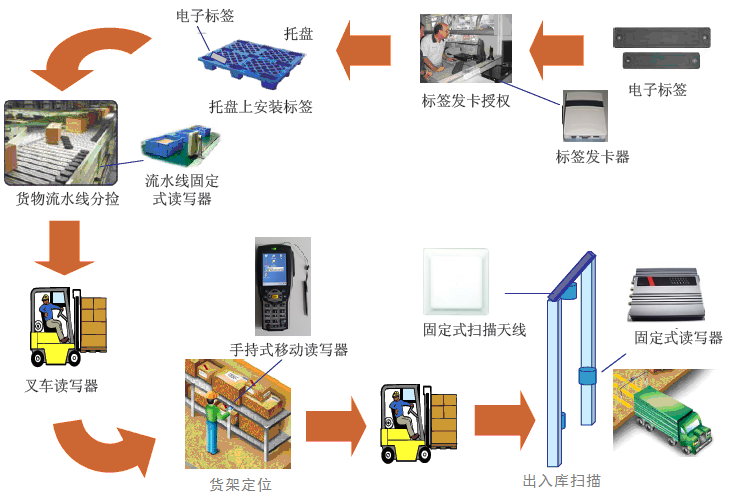
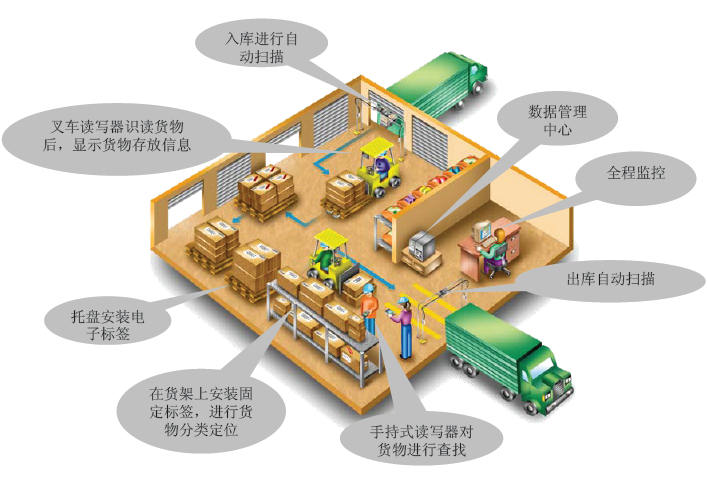
Step 1: Loading and unloading and storage
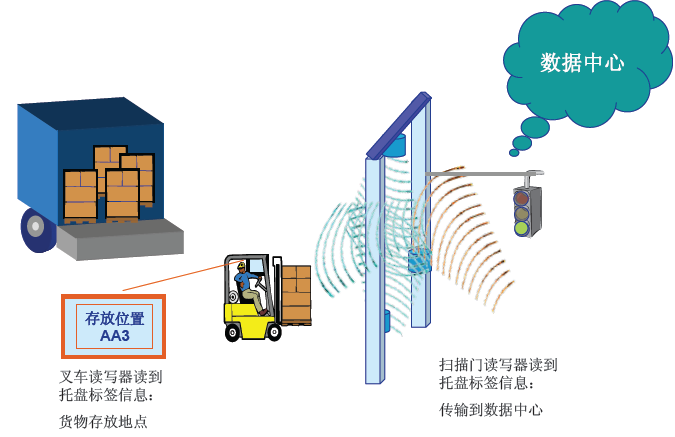
Step 2: Automatically index the forklift inventory location

Step 3: Shelf positioning
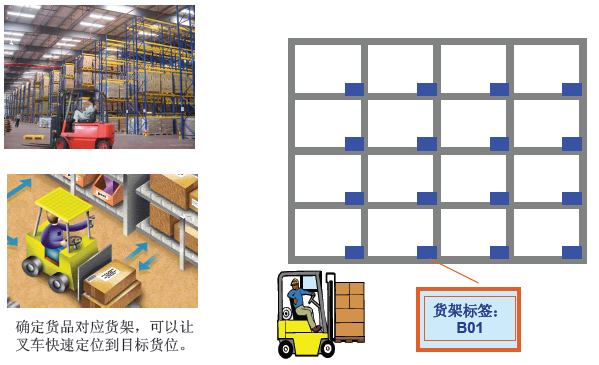
Step 4: Manage shelf cargo information
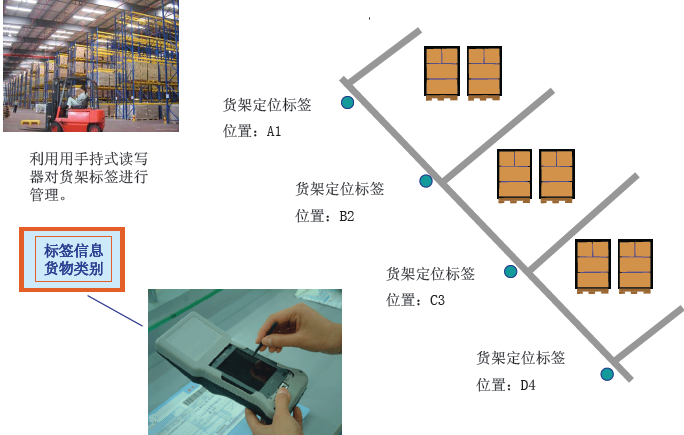
Step 5: Outbound management

1.8 RFID asset tracking management function
The traditional asset management system manages the company’s assets by number by establishing asset cards and asset detailed accounts. With the development of information technology and business, the company’s backward asset management means have led to inefficient use of the company’s assets, and even in some units, there has been chaos in asset management, which has brought huge waste and losses to enterprises. How to achieve the effective use of enterprise assets and how to ensure the integrity and safety of assets have become an important weight for enterprises to enhance their competitiveness. With the maturity of bar code technology and the improvement of RFID technology, in different application areas, the asset management system has been given a new meaning.
For enterprises, resources exist in a variety of forms, it can include production materials, equipment, vehicles, telephone poles, man-made wells, cables, and even personnel, they have a harsh environment, scattered location, small size, high value, easy to flow of different characteristics, the management of these resources, is really a headache. Finding (or taking stock) of these unknown resources and understanding their status often wastes a lot of valuable time and resources. The RFID asset management tracking system uses RFID tags, readers and software to monitor corporate resources to help them improve efficiency and return on investment. The main goal is to achieve comprehensive visibility and information transparency of enterprise resources, so that users can more refined asset management, so that they can monitor the use and flow of resources in real time, so that the utilization rate of resources is maximized, so as to ensure that those expensive resources can be obtained anytime and anywhere when they are needed.
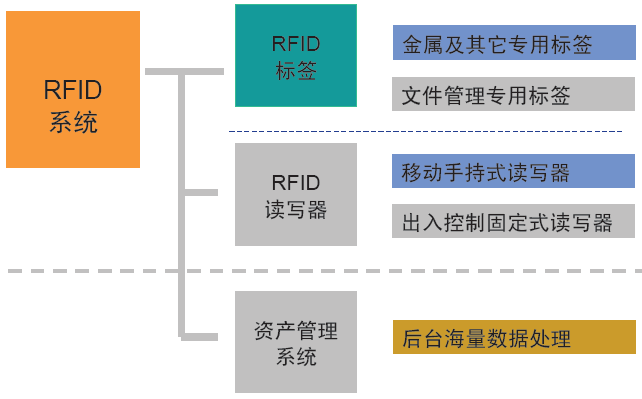
RFID asset management tracking system is based on the existing resource management system of the enterprise and the financial bar code asset management system, using electronic tags (RFID) as a marking medium, through the handheld machine and fixed reader operation to complete the data interface with the RFID background resource management system, the RFID background management system to complete the correlation with the existing fixed asset management related information, the relevant physical (asset) marking.








InfoAsia Việt Nam trở thành nhà cung cấp dịch vụ phần mềm số hóa nhà máy sản xuất cho thương hiệu giày hàng đầu thế giới NEW BALANCE
Công ty TNHH Mây Tre Hà Linh
SAP ERP MES and IOT Project for FVIV Factor
Buwon Industry Co, Ltd
KANGLONGDA VIETNAM PROTECTION TECHNOLOGY COMPANY LIMITED
Shini Group
TA TING PLASTIC (HAI DUONG ) CO., LTD
CÔNG TY TNHH MTV BIÊN HOA SCM